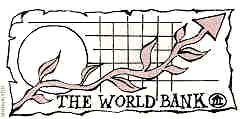Accounting green doles
 THE World Bank's (wB) staff have recently prepared a report -Mainstreaming the environment -docu- menting the progress made by the Bank in its effort to emerge as an active partner in implementing the Rio commitments for devel- opment which is environ- mentally sustainable. It is primarily an annual exercise which is carried out by the WB to self-assess its prio- rities and activities in the field of environmental management.
THE World Bank's (wB) staff have recently prepared a report -Mainstreaming the environment -docu- menting the progress made by the Bank in its effort to emerge as an active partner in implementing the Rio commitments for devel- opment which is environ- mentally sustainable. It is primarily an annual exercise which is carried out by the WB to self-assess its prio- rities and activities in the field of environmental management.
The study includes an analysis of the Bank'sgrow- ing loan portfolio of envi- ronmental projects, and its role as an implementing agency of the Global Environmental Facility and the Montreal Protocol. The report lists the $10 billion- worth active portfolio of loans that has been for- warded for 137 projects in 62 countries to show how environmental concerns are being incorporated in the Bank's developmental projects, and provides a preliminary "green account- ing" of the $67 billion that the WB has committed in the past three years.
In the preface, Andrew Steer, director of the WB's environment department, makes an effort at the perio- dic discussion of the green- ing of the Bank, and writes that the WB is now entering its "third generation" of environmental reforms that have been implemented so far.
Opera tio naldep artm en ts of the WB are in fact, strengthening their capacity for environmental analysis: the number of technical environmental staff has increased five-fold since the end of the '80s, and the creation of a new department 'vice presidency of envi- ronmentally sustainable development' is a case to point.
It is pointed out that whereas the pre- Rio period of 1987 -92 was characterised by an emphasis on the codification of environmental assessment procedures, the post-Rio period from 1992- 95 was marked by an aggres- sive effort to respond to the exploding demand allover the world for the WB'S assis- tance in environmental management.
The current emphasis is on-the-gro~nd implementation and to move "upstream" from projec~-specific con- cerns to incorporate envi- ronment into sectoral and national strategies. The report states that the WB has assisted its member coun- tries in making developm~nt sustainable arid points out that in the next three years, the Bank needs to focus its attention in particular onthe implementation of the investment and policies that have been designed over the recent past.
Chapter five of the assessment report puts special emphasis on the efforts that are being under- taken by the World Bank in reshaping its portfolio in major sectors of activity like agriculture and fore- stry. Besides, the study explores the Bank's lend- ing policy to enable improved land, water; and forest management in areas of its operation.
A major section of the report documents the envi- ronmental programmes fall- ing under the International Finance Corporation (IFC) and the Multilateral Invest- ment Guarantee Agency (MIGA). It is clear that a rapid growth in IFC and MIGA acti- vity is a reflection of the increasing and critical role played by the private sector in financing sustainable development.
